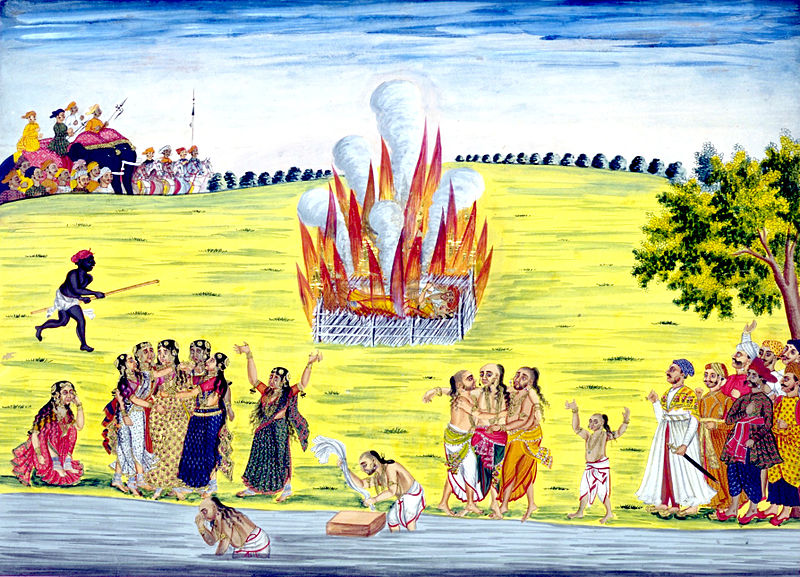Sati, also known as “Suttee,” was a tradition that was practiced in ancient India from the early centuries BCE to the mid-1990’s. In this tradition, widows were burned at the side of their deceased husbands. There were many reasons behind this tragic form of suicide, but the act was seen as heroic and courageous. The tradition originates with the goddess Sati, who burned herself to death in a fire that she created through her yogic powers, which she obtained after her father had insulted her husband. Sati became an option for women in India who were not “marriageable,” according to social norms. Sati was first recognized in the Mahabharata, one of the two most well-known and important poems of India.1
“LAMP of my life, the lips of Death
Hath blown thee out with their sudden breath;
Naught shall revive thy vanished spark . . .
Love, must I dwell in the living dark?” -Suttee by Sarojini Naidu2
The practice of Sati is recounted by a first century BCE Greek author named Diodorus Siculus. Diodorus mentioned sati stones, which were memorials of all of the wives that have passed along with their husbands. A stone was created for each wife after she gave up her life, and these stones were all collected into a shrine. The earliest memorial that has been discovered dates from 510 BCE.3

Another practice that branched out from sati was the Jahuar, which was a sacrifice of any Muslim woman from the twelfth through the sixteenth century. It was believed that if a woman was burned, she would be safe from rape, which was worse than dying at the hands of a conquering enemy.4
Sati was also practiced by the Brahmans of Bengal, by the system of law from 1100 CE, which was called Dayabhaga. If a woman was widowed, her inheritance would be given to the children of her passed husband. If she were to remarry, her inheritance from her deceased husband would be given to the children and her new husband and her other children would not receive anything. If she passed along with her husband, the inheritance would be given to the children of her dead husband. This law was ended by the Mughal rulers Akbar and his father Humayun in the sixteenth century.5
In 1829, when India was informally ruled by Great Britain, the law to make sati illegal was passed because the act was seen by the British as harsh and cruel to women. Although it was made illegal, there were controversies over whether the sati practice was a religious act, and if so, should that be taken into consideration before prohibiting it.2
In 1987, Roop Kanwar, a woman from the village of Deorala in Rajasthan India, was married to her husband for only eight months before he died. She decided against taking her life in front of thousands of people. Politicians and activists believed that Roop Kanwar was then subsequently drugged by the liquid inside the seeds of an opium poppy flower, and pressured to take her life by those around her. Some people even say that she had super natural powers because her eyes were glowing bright red as she burst into flames. Police concluded that a group of men had been guilty of having drugged her, and they were placed under arrest.7
Sati was a rather harsh tradition, but the significance of these rituals was important to many Indian traditions. The thought of self sacrifice in this way is foreign to Western traditions, and the thought of being burned alive is worse. Sati is now illegal and no longer practiced, but the memories of the dead women from this tradition remain and they will always remind us of this social practice.8
- Kashgar, 2009, s.v. “Life in India: the practice of sati or widow burning,” by Linda Heaphy. ↵
- The Denson Journal of Religion, April 2015, s.v. “Interpreting Sati: the Complex Relationship Between Gender and Power in India,” by Cheyenne Cierpial. ↵
- Dorothy Stein, Burning Widows (University of British Columbia: Pacific Affairs, 1988), 466. ↵
- The Denson Journal of Religion, April 2015, s.v. “Interpreting Sati: the complex Relationship Between gender and Power in India,” by Cheyenne Cierpial. ↵
- Encyclopedia Britannica, March 2015, s.v. “Suttee,” by Wendy Dongiger. ↵
- The Denson Journal of Religion, April 2015, s.v. “Interpreting Sati: the Complex Relationship Between Gender and Power in India,” by Cheyenne Cierpial. ↵
- Encyclopedia Britannica March 2015, s.v. “Suttee,” by Wendy Dongiger. ↵
- Sophia Gilmartin, “The Sati, the Bride and the Widow: Sacrificial Woman in the nineteenth century,” Victorian Literature Vol. 25, No.1 (1997): 142. ↵



99 comments
Evelin Joseph
The tradition of Sati was definitely an interesting topic that we approached this year in class, and it proves just how different the Indian society was compared to the rest of the world. Through this article I learned that there was even a practice, Jahuar, which branched out from the Sati practice. It was surprising to know that even though the practice was made illegal, there were still controversies surrounding it because it could also be considered a religious practice. Overall, this article was very informing and taught me a lot about this Indian tradition.
Crystalrose Quintero
Sati was an intersting culture tradition of India that I had only heard about in documentaries today. The image of the shrine of the women who gave their lives was quite moving and was surprising to see It dates back as far a 510 bce. It was interesting to read that other practices branched from sati which suggested strong influence.
Lauryn Hyde
Very interesting article. The sacrificing of wives if their husbands pass away, Sati, is an example of how different the Indian culture is to our own western culture. We could never imagine sacrificing a wife for her husbands death however they saw it as a sort of honor in most cases. We can see they saw it as an honor by the creation of sati stones for the wives.
Manuel Aguilera
I am impressed by the employing of the poem, reading as many articles as I have (not an extreme amount), I have yet to see such, kudos. As for the article, although we were taught of such a practice, I was not aware that it went into the idea of it being a religious act when it was in the process of getting illegalized. In honesty, I can see the logic behind the suicide but that is not to say I agree with it.
Ryann Cervantes
If the widow wanted to sacrifice herself this can be quite a romantic gesture from one lover to another. However, it turns cruel when it is almost made a law or tradition that forced the widows to kill themselves. It also seems like such a barbaric practice that it’s hard to imagine only up until 1829 was it finally made illegal to practice.
Liam Gillooly
Sati seems such an interesting topic. To think that women were expected to give their own lives painfully is unfathomable. The practice of Sati itself is one that is no longer compatible with the modern world. I wonder how many of those women did so unwillingly. It is sad to think that these young, vulnerable women had to throw away their lives. Great article!
Carlos Aparicio
I was never aware of any form of religion that involved suicide for a signifant other. Sati was a very serious and horrible act that women used to do. I am so happy that it is no longer practiced but I can see why it was practiced from many different aspects. This article was interesting from the start and continued to blow my mind as I kept reading. I believe that if British rule had no opinion or rule on that subject, Sati would still be a topic in today’s society in India.
Lisa Varela
Learning about other cultures is always so interesting, their beliefs and their practices. I had never heard of Sati before. As I was reading this article all I could think about was how different that practice seems by the Western half of the world. India and Britain societies both had different points of view on the issue at the time that it was being practiced. India saw it as “heroic and courageous” whereas, Britain saw it as “harsh and cruel to women.” Great news article!
Ernie Sano
The practice of Sati seems rather immoral, but who am I to argue against someone else’s traditions. Given the opportunity to speak with those who engaged in this ritual I doubt I would have any reasonable, universally true argument to give. I suppose societal expectations and customs are traditions that are difficult to escape. It’s still interesting to learn of the extreme practices mankind has thought up throughout the ages.
Zeresh Haman
This is a really crazy article! It was really well written. Its an interesting story as to how all of this got started. I think this is something that not a lot of people know about. its fascinating to think that all the women that participated were 100% fully aware of what they were doing. Its a cruel practice, and I think that its sad to think that these women felt they had to end their lives rather than live as a widow. I know that its a cultural thing, and at the time it was seen as courageous. Its a really fascinating story.